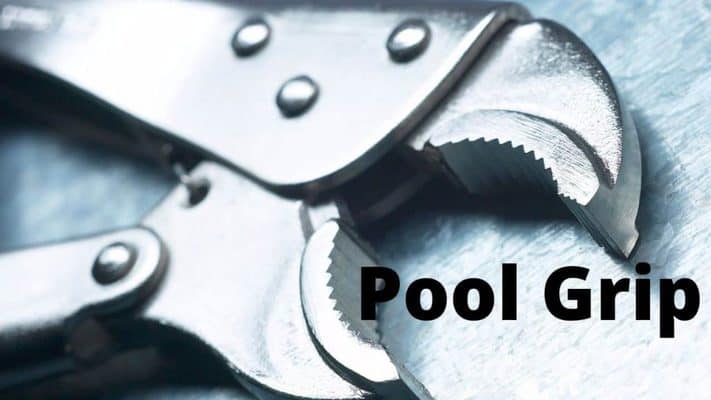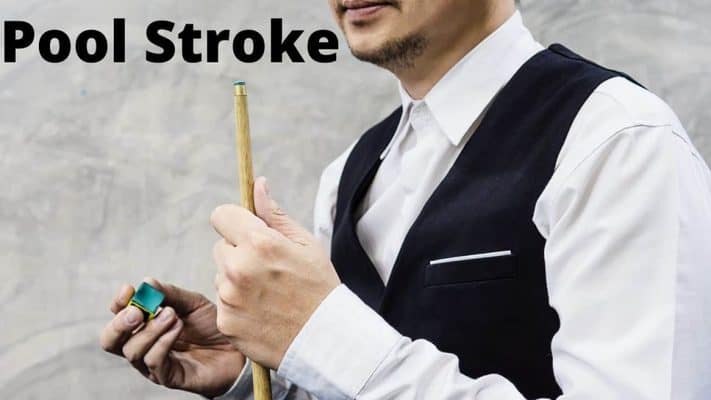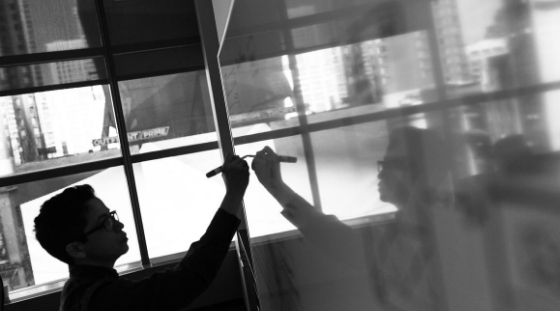HOW TO HOLD A POOL CUE – POOL CUE GRIP TECHNIQUE.
Introduction To The Cue Grip.
Learning how to hold a pool cue the correct way from day one will save you a massive amount of time and move you on to the next level. The pool cue grip determines the way the cue is delivered when striking the ball.
It is a little difficult to isolate the grip from the pool stroke as they are dependent on each other. A good pool stroke and a good pool grip will work together and are vital for great mechanics.
What Is The Pool Cue Grip For?
Your dominant hand is placed toward the rear of the cue usually a few inches behind the balance point. This hand is used to move the cue forward toward the white cue ball. Then place your non-dominant hand on the pool table to form either a closed or open bridge around 9 inches from the end of the stick.
The rear hand is the only part of the body that actually holds the pool cue and moves it forward to hit the cue ball.
How you hold the pool cue has a massive effect on the way that the cue is delivered. Your hand and wrist should allow the cue to move backward and forwards in a straight line. To get the straight-line motion players must make adjustments to their hands.
The wrist joint, unfortunately, can move and rotate in a number of different directions or planes.
One of the secrets to a straight stroke is controlling the unwanted lateral movement of the wrist.
The only thing that matters is that the cue moves in a straight line through the ball.
How Do You Control The Pool Cue Grip?
How you achieve this is up to you as an individual.
This article goes over in detail grip techniques and general principles that I have learned over the years through coaching experience, trial and error and an in-depth study of the greatest cue sports players in the world.
I see a grip method and then I try it out to see if it can be incorporated into my technique in a positive way. Some things work out well and others are a disaster, some techniques are in sync with my basic timing others are not.
We are all different, however your cue grip needs to include the basic fundamental principles that are common to all good players.
Yes, your exact grip method will probably be different to mine no doubt but also have some similar characteristics.
Lack Of Detailed Information About The Grip.
Many snooker and pool players also like to play golf. But just as a comparison it is amazing to me how many golf books have been written on the subject of the grip.
Could you imagine standing on the golf course receiving a lesson from David Ledbetter …..
….Just hold the driver however you want, in a comfortable, loose and natural position.
Don’t know about you but I would be getting a refund. Yet, if you ask most coaches that is all you will get!
For the golfer, there are books for basics, books for the draw, books for fade, books on driving and putting, hundreds of them all giving expert advice.
I did a similar search in billiards for specific advice on how to hold a pool cue with very little luck.
There was a book by the late Frank Callan called Frank Callan’s Snooker Clinic, written around the time when Steve Davis was World Champion, which I did study years ago. Frank explains in great detail how the Steve Davis grip works and the reasons for holding the cue the way he teaches. However, we are not all built the same and what works for one billiards player may not give the same results for another.
The pool grip is way more important than that!
If you have been playing pool for a while, make a small adjustment to your grip and you will immediately see that it changes your whole stroke.
There are however some things to bear in mind, some proven principles that should be incorporated into your grip. If you do copy a player’s grip, be sure to take away the essence of what is being done and not just a direct copy.
There are some strange looking grips out there being used by great players that work for them. Your job is to find a way of holding the cue that works for you and keeps the cue on the shot line.
The Hand Position.
One of the most important aspects of the grip is the way you hold the cue inside the palm of your hand. Wrap your fingers gently around the cue. As your hand moves forward and backward with the cue, there has to be an adjustment of your hand position in order to keep the cue level.
Ideally, the cue should rest on top of the fingers passing between the thumb and the first finger. The top of the cue should make contact with the soft web of skin in between.
The position of your forearm will affect the type of grip that you use.
What do I mean by this?
- If your forearm is in front of the vertical then the cue butt tends to sit more in the back of the hand.
- When your forearm is behind the vertical, 90 degrees, at the address position the cue will tend to be more in the front of your hand.
- With a neutral arm position, the butt of the cue will feel centered in the hand.
The Grip Fingers.
During the stroke, your grip fingers need to open slightly on the backswing and close as the cue moves forward.
The opening and closing of the hand should not be deliberate, or mechanical but a release of the fingers in order to keep the cue on a parallel line.
At no time during the stroke should the fingers actually leave the butt of the cue.
You should feel that the movement of the cue encourages the release of the finger pressure rather than a feeling of letting go of the cue.
Develop a Smooth Rhythm.
There should be no tension in the fingers or the wrist as the forearm moves gracefully forward and backward during the feathers and the actual shot.
Have you ever watched a gifted violinist moving the bow across the violin strings? If you have, you would have noticed that there is a smooth transition as the hand changes its direction. There is a change of wrist position to help with the change of direction.
The position of the hand, the wrist and fingers should be a result of your forearm’s position in the arc of the pendulum.
The moving parts will adjust to keep the cue in a level plane whilst staying on the shot line.
Your hand should be slightly open in the back pause position and then it should start to close around the butt of the cue as the tip accelerates towards the impact with the cue ball.
When the cue tip strikes the cue ball, the tip momentarily compresses and the energy is transferred to the ball.
The Grip On Impact With The Ball.
Due to an equal and opposite reaction, energy is also absorbed back into the cue shaft. This resulting energy needs to be controlled.
We have a 20-ounce pool cue, moving at 7-10 miles per hour, striking a stationary pool ball weighing around 6 ounces.
For further information See Newton’s laws of motion.
Because of this opposite force being delivered to the ball, there is a tendency for players to snatch at the cue butt in order to prevent it from slipping through their fingers. This is one of the worst things that you can do as it is guaranteed to pull your cue stick off the shot line.
Light Grip or Firm Grip, which one Works Best?
Which will give you a proper grip? This is a big topic but I will give it a quick mention here. The more muscles involved in a specific movement the harder it is to control the outcome of the movement or stroke in this case. Holding with a relaxed grip uses fewer muscles and tendons than playing pool with a firmer grip.
Fine muscle control is one of the first things to go out of the window when match pressure and adrenaline start to take hold.
Keep your hand on the loose side, but not such a loose grip that you lose control of the pool cue as you stroke the ball.
For more information on Light Grip or Firm Grip go here.
Hand Movement During the Stoke.
As the cue swings backward and forward in a pendulum motion the fingers generally open and close to accommodate and maintain the cue sticks level movement.
When striking the cue ball the grip hand pressure is gently transferred from the front to the back of the hand.
In the finish position, the knuckles finish pointing upwards with air to the palm of the hand. In other words, the front of the hand should be loose at the end of the forward stroke.
Try To Avoid The Following Grip Mistakes.
- Don’t place your thumb on top of the cue.
- Try not to turn your wrist too far outward or inward.
- Don’t grip the cue between your thumb and fingertips.
- Avoid a tight grip, white knuckles.
- Don’t try to crush the cue in your hand.
Don’t Snatch The Cue As It Strikes The Ball!
The above mistakes can lead to pulling the cue offline, turning the wrist and sometimes a chicken wing.
A chicken wing is when the elbow and shoulder are forced outward to the right causing the cue to move to the left for a right-handed player. It looks like something in a bucket from Colonel Sanders. This snatch should be avoided at all costs.
Try to remain in contact with the cue and control its movement without too much extra tension.
Your hand should then come to rest in the finish position. The finish position can be at the chest or further forward if you drop your elbow on the follow-through.
Delivering the cue in a straight line through the ball is probably the most important element of the cue-action grip. Look at the cue following the shot to make sure that the cue stayed on the shot line.
Any deviations from the shot line need to be corrected immediately to avoid further problems.
Generally, try to include the following good habits.
- The grip should be firm enough to pick up the cue from a table, yet relaxed enough so that the cue moves slightly within the hand.
- Grip the cue so that your forearm is at 90 degrees to the floor at the address position.
- The thumb should point downwards and the knuckles should be parallel to the cue in the set position.
- The shaft of the cue should rest lightly on the pads of your fingers with no pressure being transferred to the butt.
It is a mistake to think that this grip as described above is good for all shots.
Different Pool Cue Grips?
This is an area of some disagreement in the coaching and playing communities.
Some feel that there are several different strokes in pool, each stroke requiring a change to the grip. Each type of shot requires a slightly different grip technique in order to achieve the required result.
- Finesse stroke.
- Follow through stroke.
- Punch stroke.
Whilst other coaches maintain that the only difference with shots is tip placement and speed and that all shots can be achieved with the same hold.
Each Different Stroke requires a slight adjustment to the hand described below.
The Finesse Stroke Grip .
Is a full soft grip with a closed backswing and a measured follow through.
Used for soft plain ball shots.
This shot is played at slow to medium speed.
Follow through stroke Grip.
A full length grip with a long open backswing and a smooth follow through, accelerating through the cue ball.
This follow through grip would be used for a top spin shot and a draw shots.
Played at medium to hard speed.
Punch Stroke Grip.
Short snappy grip with very little opening of the fingers.
This type of grip would be used for a stop shot or a stun shot down the tangent line.
Played a medium speed.
Conclusion.
Find a grip that allows you free movement of the arm without any sideways motion. This grip should allow the cue to move in a straight line for various types of shot. Your grip may look different to other players’ grips but contain all of the common basic principles throughout.
Experiment and practice until you can rely on your grip to work in all situations.
How To Develop A Pre Shot Routine In Pool – Pool Shot Preparation.
How To Improve My Pool Stroke-Develop A Great Cue Action.



